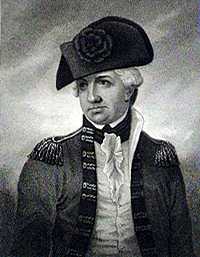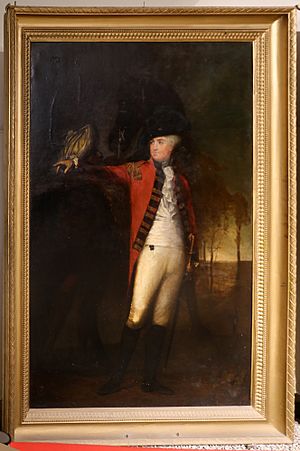William Medows facts for kids
Quick facts for kids
|
|
|---|---|

General Sir William Medows
|
|
| Born | 31 December 1738 |
| Died | 14 November 1813 (aged 74) Bath, Somerset, England |
| Allegiance | |
| Service/ |
|
| Years of service | 1756–1813 |
| Rank | General |
| Unit | 50th Regiment of Foot 5th Regiment of Foot 12th Light Dragoons 55th Regiment of Foot 89th Regiment of Foot |
| Commands held | Commander-in-Chief of Ireland Commander-in-Chief of the Bombay Army |
| Battles/wars | Seven Years' War American Revolutionary War Battle of Brandywine Battle of St. Lucia Battle of Porto Praya Battle of Monmouth Third Anglo-Mysore War Siege of Coimbatore Siege of Seringapatam |
| Awards | KB |
| Other work | Governor of Bombay |
General Sir William Medows KB (born December 31, 1738 – died November 14, 1813) was an important British Army officer. He joined the army in 1756. He fought in battles in North America, Africa (the Cape), and India. In 1788, he became the Governor of Bombay. Later, in 1790, he moved to become the Governor of Madras.
In 1790, he led 15,000 soldiers to attack Tipu Sultan of Mysore. He became the Commander-in-Chief, Ireland in 1801. He was a full general by then.
Contents
Early Military Career
William Medows was the son of Philip Medows and Lady Frances Pierrepont. He went to Eton College from 1755 to 1756. After Eton, he joined the British Army in 1756. He started as an ensign in the 50th Regiment of Foot.
In 1760, his regiment went to Germany. They joined an army led by Prince Ferdinand of Brunswick. This army was defending western Germany against the French. Medows stayed in Germany until March 1764. In 1769, he became a lieutenant-colonel in the 5th Regiment of Foot. In 1773, he moved to the 12th Light Dragoons.
Fighting in America and Beyond
In September 1775, Medows joined the 55th Regiment of Foot. This regiment was sent to the Thirteen Colonies to fight in the American Revolutionary War. In May 1776, he led the 1st Battalion of Grenadiers. These were special soldiers known for their strength.
He showed great bravery at the Battle of Brandywine in September 1777. He was badly wounded while leading his Grenadiers. In November 1777, he returned to the 5th Regiment. He still commanded the 1st Grenadier Battalion. He led them again at the Battle of Monmouth in June 1778.
In October 1778, Medows became a Brigadier General. He commanded the Advance Corps in the Battle of St. Lucia in December 1778. He again proved himself to be a very skilled leader.
He returned to Great Britain in 1780. He was made a colonel of the 89th Regiment. Medows held a high position in an expedition to the Cape of Good Hope in 1781. There was a small fight with French ships at Porto Praya. The British found the French had already strengthened the Cape. So, an attack would not work.
Medows then sailed to Madras (now Chennai) in India. He arrived in February 1782. He joined an expedition against Hyder Ali, the ruler of Mysore. But peace was made quickly, and the fighting stopped.
Leading in India

In September 1788, Medows became the Governor of Bombay. He was also the commander-in-chief of the Bombay Army. He stayed there until January 1790. Then, he moved to become the Governor of Madras. He also became the commander-in-chief of the Madras Army.
The Third Anglo-Mysore War
A war started with Tipu Sultan. He was Hyder Ali's son and the new ruler of Mysore. Lord Cornwallis, the governor-general, told Medows to start the war. On June 15, 1790, Medows led 15,000 men from Trichinopoli. They crossed into Mysore.
On July 22, the army reached Coimbatore. The enemy had left the area. Medows was able to take control of the district. However, he spread his soldiers out too much. Tipu attacked the smaller groups of soldiers. Medows had to pull his forces back to a few strong points in late 1790.
Lord Cornwallis then decided to take full command of the British army. Medows served under Cornwallis in the campaigns of 1791 and 1792. He commanded the right column in the night attack on the Seringapatam forts. This happened on February 6, 1792.
His attack went to the wrong place in the dark. He captured a different fort than planned. This left the British side open to attack. Tipu attacked this weak spot. He almost got his position back. Lord Cornwallis was slightly wounded. Tipu eventually asked for peace. The fighting ended on February 25 while they talked about peace terms.
Peace was agreed upon with the Treaty of Seringapatam on March 18. Medows gave up his share of the prize-money (nearly £5,000). He gave it to his troops instead. He left for Great Britain in August 1792.
Later Life and Legacy
On December 14, 1792, he was made a Knight of the Bath. This is a special honor. On October 12, 1793, he became a lieutenant-general. In November 1796, he was given command of the 7th Dragoon Guards. On January 1, 1798, he became a full general. He also became the Lieutenant-Governor of the Isle of Wight. In 1801, he briefly took over from Cornwallis as Commander-in-Chief, Ireland.
Sir William Medows died in Bath on November 14, 1813. He was 74 years old.

